Changes in Runoff and Sediment Loads in the Tuhai River Basin and the Factors Influencing These Changes
Abstract
:1. Introduction
2. Materials and Methods
2.1. Study Area
2.2. Research Methods
2.2.1. Data Sources
2.2.2. Data Analyses
3. Results
3.1. Inter-Annual Variations in Runoff and Sediment Load
3.2. Inter-Annual Abrupt Points of Runoff and Sediment Load
3.3. Relationship between Runoff and Sediment Load
3.4. Factors Influencing Runoff and Sediment Load
4. Discussion
5. Conclusions
Limitations of the Study
Author Contributions
Funding
Data Availability Statement
Conflicts of Interest
References
- Vorosmarty, C.J.; Green, P.; Salisbury, J.; Lammers, R.B. Global water resources: Vulnerability from climate change and population growth. Science 2000, 289, 284–288. [Google Scholar] [CrossRef] [PubMed]
- Ghimire, S.; Singh, U.; Panthi, K.K.; Bhattarai, P.K. Suspended sediment source and transport mechanisms in a Himalayan River. Water 2024, 16, 1063. [Google Scholar] [CrossRef]
- Piao, S.; Ciais, P.; Huang, Y.; Shen, Z.; Peng, S.; Li, J.; Zhou, L.; Liu, H.; Ma, Y.; Ding, Y.; et al. The impacts of climate change on water resources and agriculture in China. Nature 2010, 467, 43–51. [Google Scholar] [CrossRef] [PubMed]
- Li, L.; Ni, J.; Chang, F.; Yue, Y.; Frolova, N.; Magritsky, D.; Borthwick, A.G.L.; Ciais, P.; Wang, Y.; Zheng, C.; et al. Global trends in water and sediment fluxes of the world’s large rivers. Sci. Bull. 2020, 65, 62–69. [Google Scholar] [CrossRef] [PubMed]
- Zhang, J.; Wang, J.; Zhao, N.; Shi, J.; Wang, Y. Analysis of changes in runoff and sediment load and their attribution in the Kuye River Basin of the middle Yellow River based on the slope change ratio of cumulative quantity method. Water 2024, 16, 944. [Google Scholar] [CrossRef]
- Dethier, E.N.; Sartain, S.L.; Renshaw, C.E.; Magilligan, F.J. Spatially coherent regional changes in seasonal extreme streamflow events in the United States and Canada since 1950. Sci. Adv. 2020, 6, eaba5939. [Google Scholar] [CrossRef] [PubMed]
- Liu, J.; Zhang, Q.; Singh, V.P.; Shi, P. Contribution of multiple climatic variables and human activities to streamflow changes across China. J. Hydrol. 2017, 545, 145–162. [Google Scholar] [CrossRef]
- Zhao, G.; Tian, P.; Mu, X.; Jiao, J.; Wang, F.; Gao, P. Quantifying the impact of climate variability and human activities on streamflow in the middle reaches of the Yellow River basin, China. J. Hydrol. 2014, 519, 387–398. [Google Scholar] [CrossRef]
- Liang, S.; Yan, T.; Gao, H.; Jing, C.; He, F.; Han, M. Evolution of the Pingluo Section of the upper Yellow River over the past 50 years: Responses to environmental change and human activity. Water 2024, 16, 911. [Google Scholar] [CrossRef]
- Luce, C.H.; Holden, Z.A. Declining annual streamflow distributions in the Pacific Northwest United States, 1948–2006. Geophys. Res. Lett. 2009, 36, L16401. [Google Scholar] [CrossRef]
- Lu, X. Vulnerability of water discharge of large Chinese rivers to environmental changes: An overview. Reg. Environ. Change 2004, 4, 182–191. [Google Scholar] [CrossRef]
- Li, T.; Wang, S.; Liu, Y.; Zhao, W. Driving forces and their contribution to the recent decrease in sediment flux to ocean of major rivers in China. Sci. Total Environ. 2018, 634, 534–541. [Google Scholar] [CrossRef]
- Alsharhan, A.S.; Rizk, Z.E. Overview on global water resources. In Water Resources and Integrated Management of the United Arab Emirates; Springer: Cham, Switzerland, 2020; pp. 17–61. [Google Scholar]
- Cui, B.; Chang, X.; Shi, W. Abrupt changes of runoff and sediment load in the lower reaches of the Yellow River, China. Water Resour. 2014, 41, 252–260. [Google Scholar] [CrossRef]
- Yang, M.; Mao, D.; Liu, P.; Liu, W. Analysis of Characteristics of annual runoff and sediment in Dongting Lake during 1951–2015. Eng. J. Wuhan Univ. 2018, 51, 1050–1062+1071, (In Chinese with English Abstract). [Google Scholar]
- Yang, L.; Zhao, G.; Tian, P.; Mu, X.; Tian, X.; Feng, J.; Bai, Y. Runoff changes in the major river basins of China and their responses to potential driving forces. J. Hydrol. 2022, 607, 127536. [Google Scholar] [CrossRef]
- Gao, P.; Mu, X.; Wang, F.; Li, R. Changes in streamflow and sediment discharge and the response to human activities in the middle reaches of the Yellow River. Hydrol. Earth Syst. Sci. 2011, 15, 1–10. [Google Scholar] [CrossRef]
- Feng, X.; Fu, B.; Piao, S.; Wang, S.; Ciais, P.; Zeng, Z.; Lü, Y.; Zeng, Y.; Li, Y.; Jiang, X.; et al. Revegetation in Chinese Loess Plateau is approaching sustainable water resource limits. Nat. Clim. Change 2016, 6, 1019–1022. [Google Scholar] [CrossRef]
- Xu, H.; Ren, Y.; Zheng, H.; Ouyang, Z.; Jiang, B. Analysis of runoff trends and drivers in the Haihe River basin, China. Int. J. Environ. Res. Public Health 2020, 17, 1577. [Google Scholar] [CrossRef]
- Yang, Y.; Tian, F. Abrupt change of runoff and its major driving factors in Haihe River catchment, China. J. Hydrol. 2009, 374, 373–383. [Google Scholar] [CrossRef]
- Yang, Y. Mechanisms resulting in sharp decrease of runoff in Haihe catchment of North China. In Proceedings of the General Assembly Conference Abstracts, Vienna, Austria, 22–27 April 2012; p. 1722. [Google Scholar]
- Wang, C.; Xu, L.; Fu, X. Studies on water resources carrying capacity in Tuhai river basin based on ecological footprint. IOP Conf. Ser. Earth Environ. Sci. 2017, 64, 012030. [Google Scholar] [CrossRef]
- Wang, J.; Ran, J.; Wu, W.; Shang, R.; Zhang, S.; Zhang, Z.; Zhang, M.; Liu, J. Scaling effects of anthropogenic and climate change impacts on runoff in the Haihe River Basin. J. Ecol. Rural Environ. 2024, 40, 757–765, (In Chinese with English Abstract). [Google Scholar]
- Han, Y.; Zhang, S. Characteristics of runoff variations and their influencing factor in Haihe River Basin. J. Water Resour. Water Eng. 2021, 32, 7–13, (In Chinese with English Abstract). [Google Scholar]
- Kong, K.; Wang, K.; Xu, Z.; Cong, X. Simulation and analysis of rain-flood routing under multi-stage sluices regulation in Tuhai River Basin. DEStech Trans. Soc. Sci. Educ. Hum. Sci. 2017. [Google Scholar] [CrossRef] [PubMed]
- Dong, L.; Li, D. Variation trend and mutation analysis of runoff in Tuhai River watershed. J. Binzhou Univ. 2016, 32, 79–85, (In Chinese with English Abstract). [Google Scholar]
- Zhuang, F. Variation trend and analysis of the runoff on the upstream of the Tuhai River in Haihe River Basin. J. Agric. Catastrophol. 2021, 11, 143–144+150, (In Chinese with English Abstract). [Google Scholar]
- Kendall, M.G. Rank Correlation Methods; Charles Griffin: London, UK, 1975. [Google Scholar]
- Mann, H.B. Non-parametric test against trend. Econometrica 1945, 13, 245–259. [Google Scholar] [CrossRef]
- de Oliveira, R.G.; Valle Júnior, L.C.G.; da Silva, J.B.; Espíndola, D.A.L.F.; Lopes, R.D.; Nogueira, J.S.; Curado, L.F.A.; Rodrigues, T.R. Temporal trend changes in reference evapotranspiration contrasting different land uses in southern Amazon basin. Agric. Water Manag. 2021, 250, 106815. [Google Scholar] [CrossRef]
- Ouellet-Proulx, S.; St-Hilaire, A.; Courtenay, S.C.; Haralampides, K.A. Estimation of suspended sediment concentration in the Saint John River using rating curves and a machine learning approach. Hydrolog. Sci. J. 2016, 61, 1847–1860. [Google Scholar] [CrossRef]
- Hu, B.; Wang, H.; Yang, Z.; Sun, X. Temporal and spatial variations of sediment rating curves in the Changjiang (Yangtze River) basin and their implications. Quat. Int. 2011, 230, 34. [Google Scholar] [CrossRef]
- Gao, P.; Li, P.; Zhao, B.; Xu, R.; Zhao, G.; Sun, W.; Mu, X. Use of double mass curves in hydrologic benefit evaluations. Hydrol. Process. 2017, 31, 4639. [Google Scholar] [CrossRef]
- Chang, J.; Zhang, H.; Wang, Y.; Zhu, Y. Assessing the impact of climate variability and human activities on streamflow variation. Hydrol. Earth Syst. Sci. 2016, 20, 1547–1560. [Google Scholar] [CrossRef]
- Ahn, K.; Merwade, V. Quantifying the relative impact of climate and human activities on streamflow. J. Hydrol. 2014, 515, 257–266. [Google Scholar] [CrossRef]
- Flood Prevention Scheme of Tuhai River in Shandong Province in 2023; Shandong Provincial Water Resources Department: Shandong, China, May 2023.
- Kong, D.; Miao, C.; Wu, J.; Duan, Q. Impact assessment of climate change and human activities on net runoff in the Yellow River Basin from 1951 to 2012. Ecol. Eng. 2016, 91, 566–573. [Google Scholar] [CrossRef]
- Feng, S.; Mu, X.; Gao, P.; Xie, Z. Trends of runoff and sediment loads in the Jinghe River basin and influencing factors. J. Arid Land Resour. Environ. 2022, 36, 151–157, (In Chinese with English Abstract). [Google Scholar]
- Liu, Y.; Guan, Z.; Tian, J.; Liu, R.; Guan, R. Runoff change and its driving factors in Jinghe River basin in recent 70 years. Arid land Geogr. 2022, 45, 17–26, (In Chinese with English Abstract). [Google Scholar]
- IPCC. Climate Change 2013: The Physical Science Basis; Cambridge University Press: Cambridge, UK, 2013. [Google Scholar]
- Li, Z.; Quiring, S.M. Investigating spatial heterogeneity of the controls of surface water balance in the contiguous United States by considering anthropogenic factors. J. Hydrol. 2021, 601, 126621. [Google Scholar] [CrossRef]
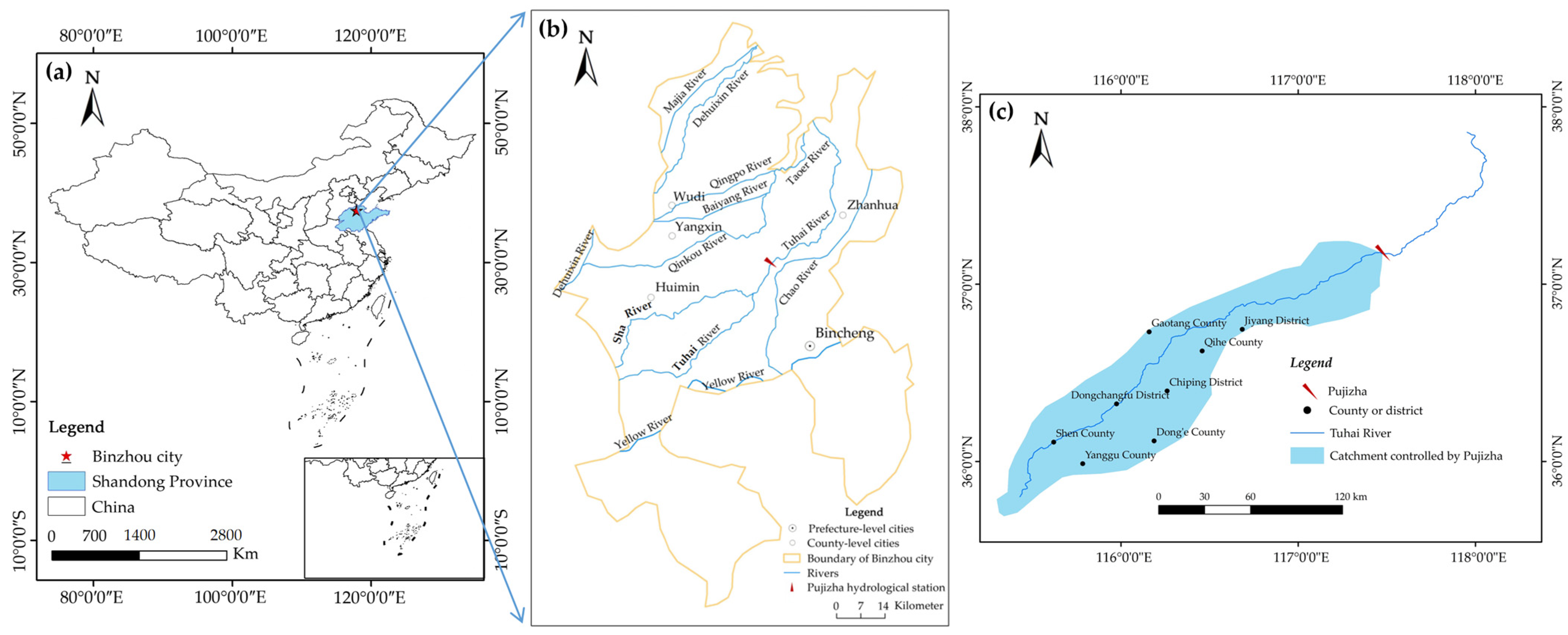
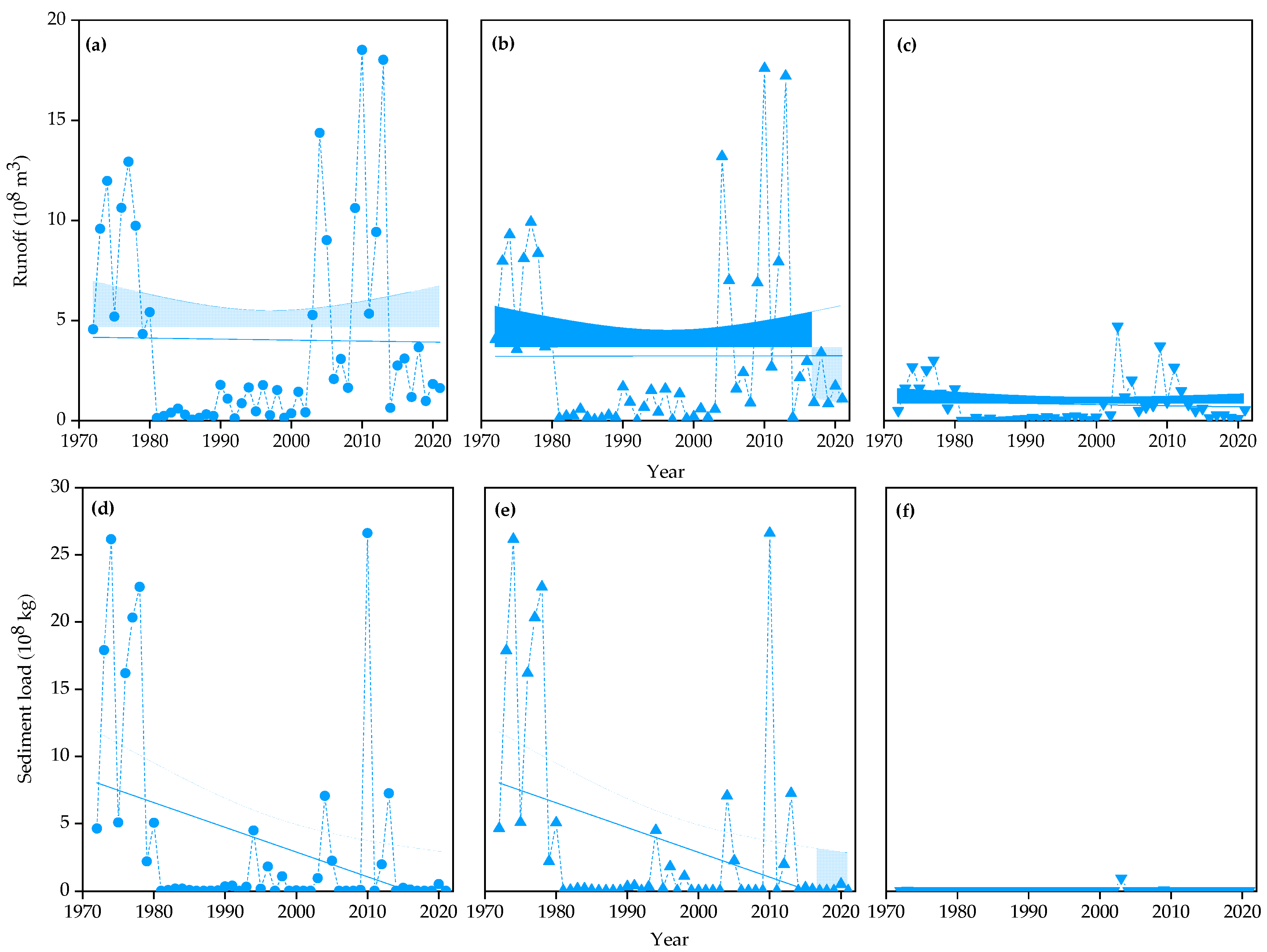
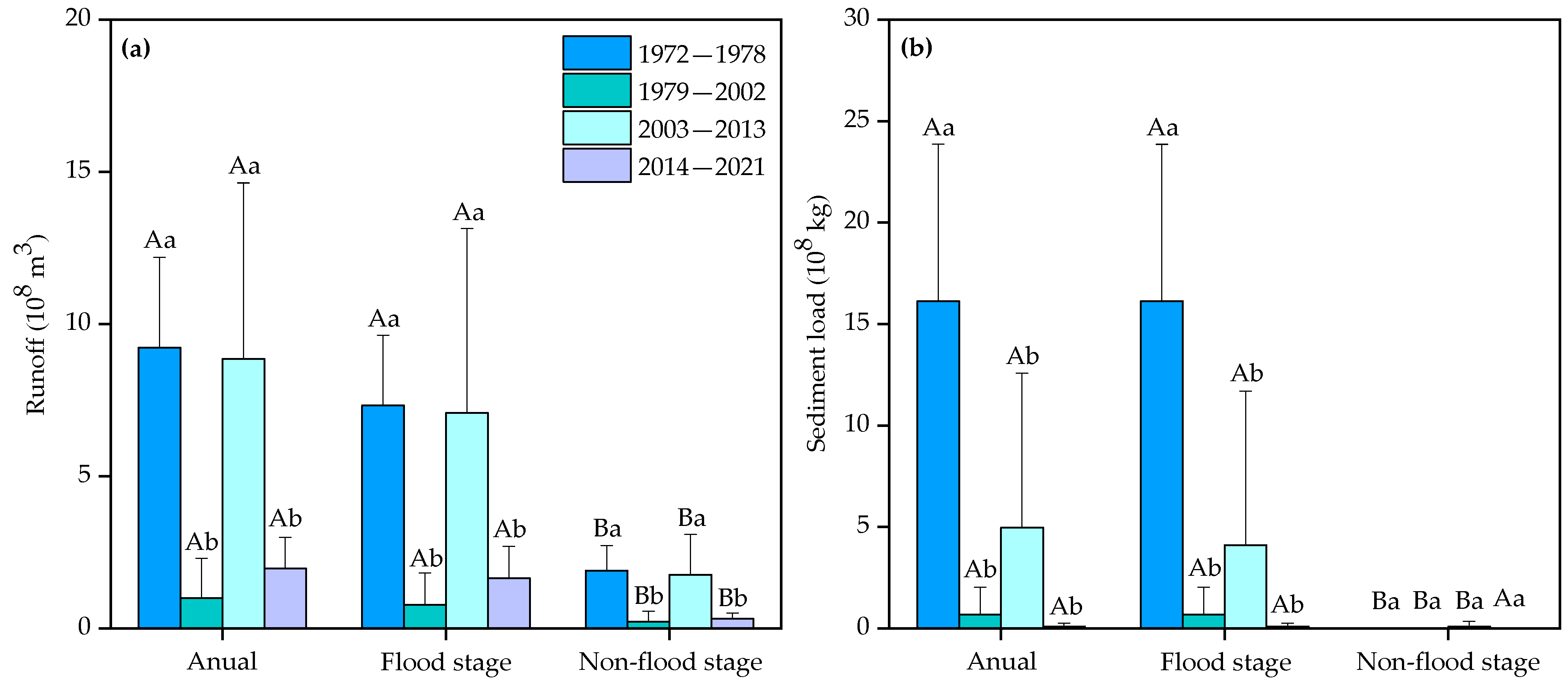

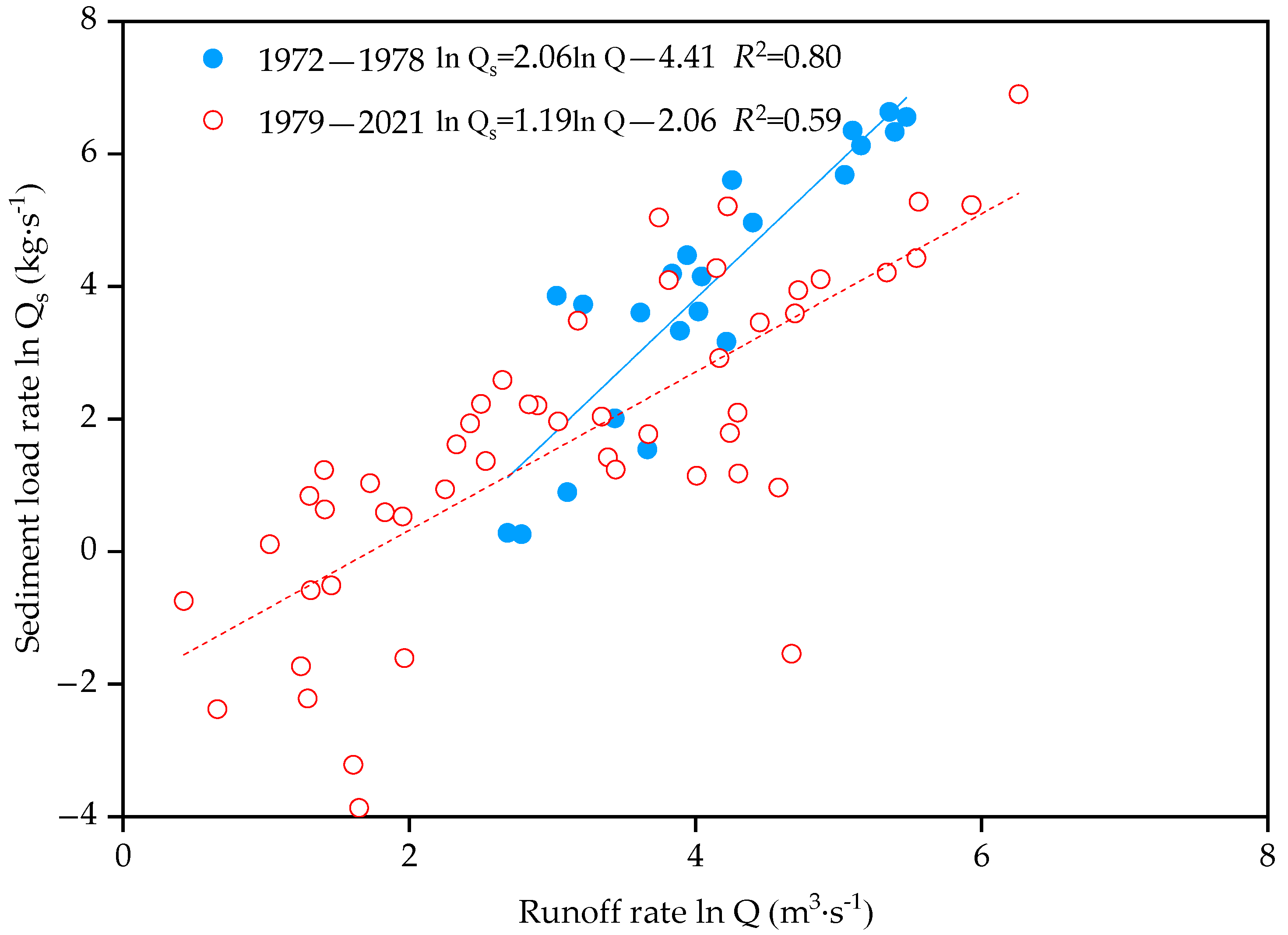
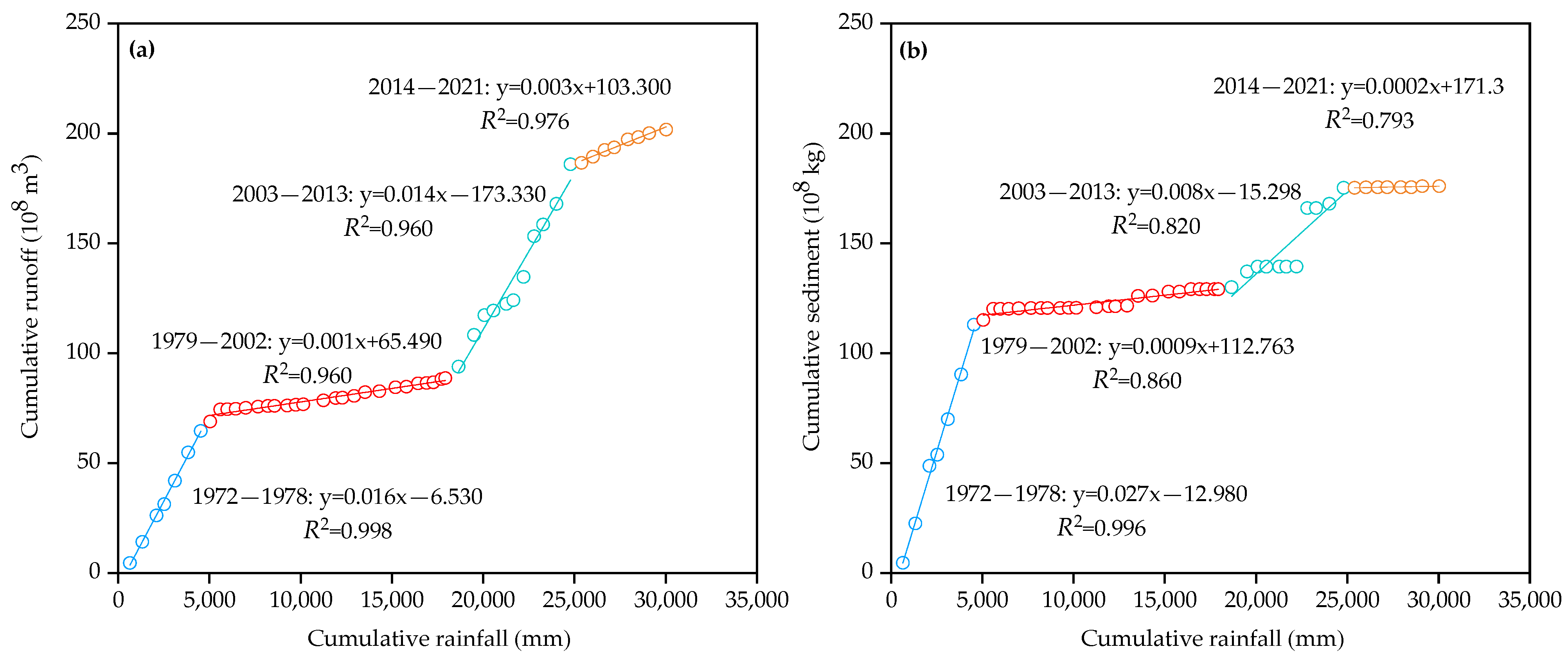
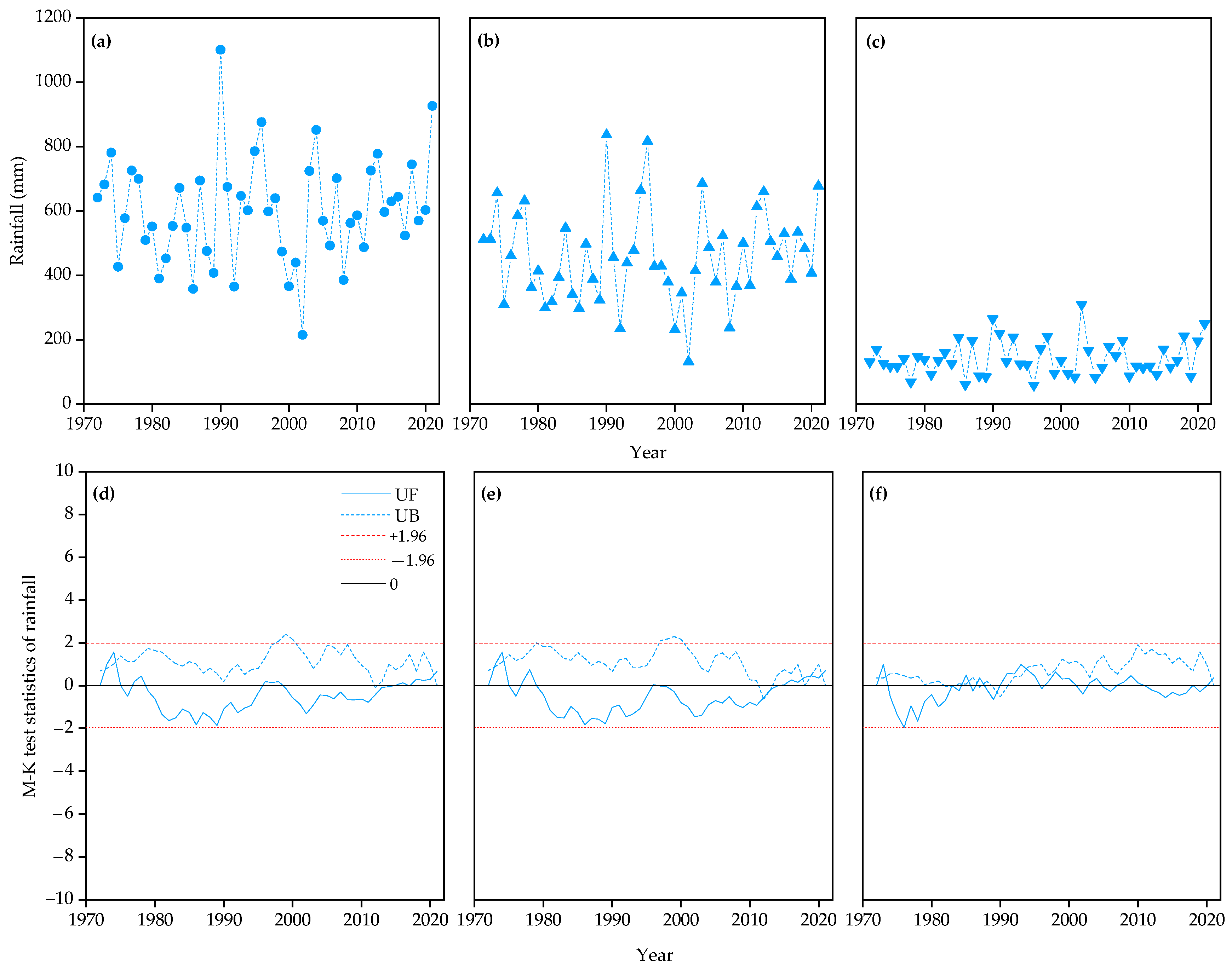
| Indicators | Runoff | Sediment | ||
|---|---|---|---|---|
| Z | Trend | Z | Trend | |
| Annual | 0.80 | ↑ | −2.89 ** | ↓ |
| Flood stage | 0.33 | ↑ | −3.18 ** | ↓ |
| Non-flood stage | 0.82 | ↑ | −0.14 | ↓ |
| Time Series | 1979–2002 | 2003–2013 | 2014–2021 |
|---|---|---|---|
| Human governance measures | River regulation: 31.1 km; New dam: 18 km; Waterlogging-prone area: 3.37 × 105 ha | River regulation: 18.4 km; River dredging: 5.64 km; River channel protection: 3.54 km | River regulation: 84.24 km; River dredging: 207.53 km; River channel protection: 2.42 km; Dredging earthwork: 1.69 × 107 m3; New drainage culverts: 5; Maintenance and renovation of 168 culverts and 47 bridges |
| Indicator | Stages | 1972–2021 (n = 50) | 1972–1978 (n = 7) | 1979–2021 (n = 43) | ||||||
|---|---|---|---|---|---|---|---|---|---|---|
| Annual | Flood Stage | Non-Flood Stage | Annual | Flood Stage | Non-Flood Stage | Annual | Flood Stage | Non-Flood Stage | ||
| Runoff | Annual | 0.326 * | 0.394 ** | −0.081 | 0.676 | 0.652 | 0.073 | 0.122 | 0.203 | −0.167 |
| Flood stage | 0.333 * | 0.425 ** | −0.139 | 0.765 * | 0.749 | 0.039 | 0.118 | 0.204 | −0.182 | |
| Non-flood stage | 0.142 | 0.085 | 0.196 | 0.290 | 0.248 | 0.154 | 0.118 | −0.041 | 0.457 ** | |
| Sediment load | Annual | 0.229 | 0.330 * | −0.198 | 0.783 * | 0.810 * | −0.125 | 0.282 | 0.334 * | −0.030 |
| Flood stage | 0.227 | 0.331 * | −0.206 | 0.783 * | 0.810 * | −0.126 | 0.289 | 0.369 * | −0.102 | |
| Non-flood stage | 0.109 | −0.048 | 0.454 ** | 0.130 | −0.042 | 0.657 | 0.087 | −0.013 | 0.291 | |
| Stage | Annual Runoff (108 m3) | Rainfall | Human Activities | ||||
|---|---|---|---|---|---|---|---|
| Measured Value | Estimated Value | Total Reduction | Reduction (108 m3) | Ratio | Reduction (108 m3) | Ratio | |
| 1972–1978 | 9.23 | 9.43 | |||||
| 1979–2002 | 1.00 | 8.32 | 8.23 | 0.91 | 11.1% | 7.32 | 88.9% |
| 2003–2013 | 8.85 | 8.34 | 0.38 | 0.89 | |||
| 2014–2021 | 1.97 | 6.16 | 7.26 | 3.07 | 42.3% | 4.19 | 57.7% |
| Stages | Annual Sediment Load (108 kg) | Rainfall | Human Activities | ||||
|---|---|---|---|---|---|---|---|
| Measured Value | Estimated Value | Total Reduction | Reduction (108 kg) | Ratio | Reduction (108 kg) | Ratio | |
| 1972–1978 | 16.13 | 15.64 | |||||
| 1979–2002 | 0.67 | 13.96 | 15.46 | 2.17 | 14.0% | 13.29 | 86.0% |
| 2003–2013 | 4.19 | 13.89 | 11.94 | 2.24 | 18.8% | 9.70 | 81.2% |
| 2014–2021 | 0.10 | 10.21 | 16.03 | 5.92 | 36.9% | 10.11 | 63.1% |
Disclaimer/Publisher’s Note: The statements, opinions and data contained in all publications are solely those of the individual author(s) and contributor(s) and not of MDPI and/or the editor(s). MDPI and/or the editor(s) disclaim responsibility for any injury to people or property resulting from any ideas, methods, instructions or products referred to in the content. |
© 2024 by the authors. Licensee MDPI, Basel, Switzerland. This article is an open access article distributed under the terms and conditions of the Creative Commons Attribution (CC BY) license (https://creativecommons.org/licenses/by/4.0/).
Share and Cite
Cao, Q.; Zong, X.; Qi, C.; Yu, C.; Guo, J.; Shen, J.; Wei, S.; Wang, D.; Zhang, J.; Xia, J. Changes in Runoff and Sediment Loads in the Tuhai River Basin and the Factors Influencing These Changes. Water 2024, 16, 2064. https://doi.org/10.3390/w16142064
Cao Q, Zong X, Qi C, Yu C, Guo J, Shen J, Wei S, Wang D, Zhang J, Xia J. Changes in Runoff and Sediment Loads in the Tuhai River Basin and the Factors Influencing These Changes. Water. 2024; 16(14):2064. https://doi.org/10.3390/w16142064
Chicago/Turabian StyleCao, Qiqi, Xianguo Zong, Chaozhen Qi, Chuanning Yu, Jianyao Guo, Jingxia Shen, Shoucai Wei, Dong Wang, Jun Zhang, and Jiangbao Xia. 2024. "Changes in Runoff and Sediment Loads in the Tuhai River Basin and the Factors Influencing These Changes" Water 16, no. 14: 2064. https://doi.org/10.3390/w16142064
APA StyleCao, Q., Zong, X., Qi, C., Yu, C., Guo, J., Shen, J., Wei, S., Wang, D., Zhang, J., & Xia, J. (2024). Changes in Runoff and Sediment Loads in the Tuhai River Basin and the Factors Influencing These Changes. Water, 16(14), 2064. https://doi.org/10.3390/w16142064






